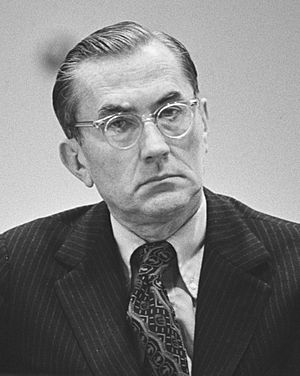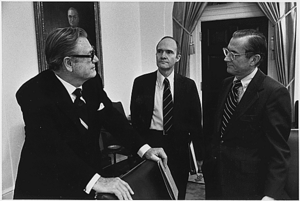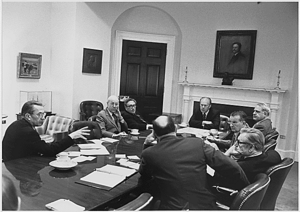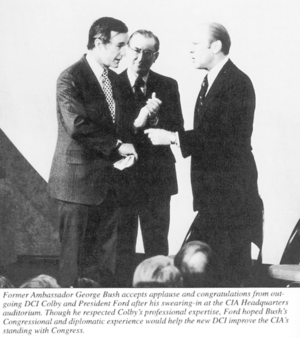William Colby facts for kids
Quick facts for kids
William Colby
|
|
|---|---|
 |
|
| 10th Director of Central Intelligence | |
| In office September 4, 1973 – January 30, 1976 |
|
| President | Richard Nixon Gerald Ford |
| Deputy | Vernon A. Walters |
| Preceded by | Vernon A. Walters (Acting) |
| Succeeded by | George H. W. Bush |
| Deputy Director of Central Intelligence for Operations | |
| In office March 2, 1973 – August 24, 1973 |
|
| President | Richard Nixon |
| Preceded by | Thomas Karamessines |
| Succeeded by | William Nelson |
| Personal details | |
| Born |
William Egan Colby
January 4, 1920 St. Paul, Minnesota, U.S. |
| Died | May 6, 1996 (aged 76) Rock Point, Maryland, U.S. |
| Resting place | Arlington National Cemetery Arlington, Virginia |
| Spouses | Barbara Heinzen (1945–1984) Sally Shelton (1984–1996) |
| Children | 5 (with Heinzen) |
| Education | Princeton University (A.B.) Columbia University (LL.B.) |
| Military service | |
| Allegiance | |
| Branch/service | |
| Unit | Office of Strategic Services |
| Battles/wars | World War II |
William Egan Colby (January 4, 1920 – May 6, 1996) was an American intelligence officer. He served as the head of the Central Intelligence Agency (CIA) from September 1973 to January 1976. This role is called the Director of Central Intelligence (DCI).
During World War II, Colby worked with the Office of Strategic Services (OSS). After the war, he joined the new Central Intelligence Agency (CIA). Before and during the Vietnam War, Colby worked in Vietnam. He was the chief of the CIA's Far East Division and led a program called Civil Operations and Rural Development. He also oversaw the Phoenix Program. After Vietnam, Colby became the DCI. He was very open about U.S. intelligence activities to Congress and the media. Colby served under Presidents Richard Nixon and Gerald Ford. He was replaced by George H. W. Bush.
Contents
Early Life and Family Background
William Egan Colby was born in Saint Paul, Minnesota, in 1920. His father, Elbridge Colby, was a military officer and professor. His family had a history of military service. William's mother, Margaret Egan, came from an Irish family active in business and politics.
Because his father was in the Army, William moved around a lot. He went to high school in Burlington, Vermont. Then he studied at Princeton University and Columbia Law School. Colby learned from his parents to serve others and to be independent. He was a lifelong Roman Catholic.
In 1945, he married Barbara Heinzen. They had five children. Later, in 1984, he married Sally Shelton-Colby.
William Colby's Career Journey
Serving in World War II
After his first year of law school in 1941, Colby joined the United States Army. He served with the Office of Strategic Services (OSS). This group trained "Jedburghs" to work with resistance fighters in Europe. Their goal was to bother German forces. During World War II, he parachuted behind enemy lines twice. He earned the Silver Star medal for his bravery. He also received awards from Norway, France, and Great Britain.
In August 1944, he went to France and worked with the French resistance. In April 1945, he led a mission into Norway. His team's goal was to destroy railway lines. This would stop German forces in Norway from helping in Germany.
After the war, Colby finished law school. He worked briefly as a lawyer in New York. He then moved to Washington to work for the National Labor Relations Board.
Working for the Central Intelligence Agency
CIA Work in Europe



An OSS friend offered Colby a job at the Central Intelligence Agency (CIA). Colby accepted. He spent the next 12 years working in other countries. First, he was in Stockholm, Sweden. There, he helped set up secret networks. These networks were designed to make any Soviet occupation difficult.
Colby then spent much of the 1950s in Rome, Italy. He pretended to be a State Department officer. His real job was to lead the CIA's secret political work. He supported anti-Communist parties in elections. This helped stop the Communist Party from gaining power.
CIA Work in Vietnam and Asia
In 1959, Colby became the CIA's deputy chief in Saigon, South Vietnam. He later became the chief of station there until 1962. The CIA asked him to support the government of Ngô Đình Diệm. Colby believed that "the key to the war in Vietnam was the war in the villages." He worked hard to help the Vietnamese fight the Viet Cong in the countryside.
In 1962, he returned to Washington. He became the chief of the CIA's Far East Division. During these years, Colby was deeply involved in U.S. policies in East Asia. This included Vietnam, Indonesia, Japan, Korea, and China.
In 1968, President Lyndon Johnson sent Colby back to Vietnam. Colby became the head of a U.S./South Vietnamese program called CORDS. This program focused on helping people in rural areas. Part of this effort was the Phoenix Program. This program aimed to find and stop the "Viet Cong Infrastructure." There is much debate about this program. Some people said it involved bad tactics like assassination. Colby always said that such tactics were not allowed.
Colby, along with other leaders, tried a new way to fight the war. They focused more on winning over the local people. They also worked to secure the countryside. Some people believe this approach helped reduce the Communist uprising in South Vietnam. However, South Vietnam eventually fell to North Vietnamese forces in 1975. This happened after the U.S. stopped providing air and ground support.
Leading the CIA
Colby returned to Washington in July 1971. He became the executive director of the CIA. In 1973, President Nixon chose James Schlesinger to lead the CIA. Schlesinger wanted to reform the CIA. Colby agreed with this idea. When Schlesinger became Secretary of Defense, Colby was chosen to be the new Director of Central Intelligence (DCI).
Colby's time as DCI lasted two and a half years. It was a difficult period. Congress and the media were investigating U.S. intelligence activities. These investigations were known as the Church and Pike committees. Colby decided to be very open about the CIA's work.
During his time as DCI, important world events happened. The Yom Kippur War broke out in 1973. This war surprised American intelligence. In 1975, South Vietnam fell to Communist forces. This was a very hard moment for Colby. He had spent so much of his life working there.
Colby also worked to make changes within the CIA. He tried to update old ways of doing things. He also spoke about the importance of free speech. He said the CIA should protect civil rights, not prevent them.
President Ford, advised by Henry Kissinger, replaced Colby in late 1975. George H. W. Bush became the new CIA Director. Colby was offered another job but turned it down.
After His Time at the CIA
In 1977, Colby started a law firm in Washington, D.C. He worked on public policy issues. He also supported reducing military spending. He continued to advise on intelligence matters.
Colby wrote two books about his life and work. One was called Honorable Men: My Life in the CIA. The other, about Vietnam, was called Lost Victory. In Lost Victory, Colby argued that the U.S. efforts in Vietnam had succeeded by the early 1970s. He believed South Vietnam could have survived if the U.S. had kept helping after the Paris Accords.
Colby also helped with the video game Spycraft: The Great Game. He appeared in the game as himself.
Death
On April 27, 1996, Colby went on a solo canoe trip from his home in Rock Point, Maryland. His canoe was found the next day in the Wicomico River. Colby was found dead.
Legacy
Many books and a documentary have been made about William Colby. His son, Carl Colby, released a documentary called The Man Nobody Knew in 2011. Norwich University hosts an annual writing event named in his honor.
His grandson, Elbridge A. Colby, also served in government. He was a Deputy Assistant Secretary of Defense from 2017 to 2018.
Quotes
- "We disbanded our intelligence [after both world wars] and then found we needed it. Let's not go through that again. Redirect it, reduce the amount of money spent, but let's not destroy it. Because you don't know 10 years out what you're going to face."
- "The more we know about each other the safer we all are." — Colby to Leonid Brezhnev
- On walking alone, unfollowed, through Red Square in 1989, after the end of the Cold War: "That was my victory parade."
Biographies of Colby
- Colby, Carl (2011). Colby: A Secret Life of a CIA Spymaster. Annapolis, Md: Naval Institute. ISBN 9781591141228. OCLC 751577970.
- Ford, Harold P. (1993). William E. Colby as Director of Central Intelligence, 1973-1976. Washington, D.C.: Central Intelligence Agency. Declassified official CIA history of Colby's tenure, available at nsarchive.gwu.edu: http://nsarchive.gwu.edu/NSAEBB/NSAEBB362/
- Prados, John (2009). William Colby and the CIA: The Secret Wars of a Controversial Spymaster. Lawrence, KS: University Press of Kansas. ISBN 9780700616909. OCLC 320185462.
- Waller, Douglas C. (2015). Disciples: The World War II Spy Story of the Four OSS Men Who Later Led the CIA: Allen Dulles, Richard Helms, William Colby, William Casey. New York: Simon & Schuster. ISBN 9781451693720. OCLC 911179767.
- Woods, Randall B. (2013). Shadow Warrior: William Egan Colby and the CIA. Basic Books. ISBN 9780465021949. OCLC 812081249.
Additional sources
- Evaluation of his tenure by CIA historian/official.
- Sorley, Lewis (1999). A Better War: The Unexamined Victories and Final Tragedy of America's Last Years in Vietnam. Harcourt. ISBN 0-15-100266-5. https://archive.org/details/betterwarunexam00sorl.
- Garthoff, Douglas (2005). Directors of Central Intelligence as Leaders of the U.S. Intelligence Community, 1946–2005. Central Intelligence Agency. ISBN 1-929667-14-0.
- Talk on Colby's legacy by University of Arkansas Cold War historian Randall Woods.
- Fallaci, Oriana (1977). Interview With History. Houghton Mifflin. ISBN 0-395-25223-7. https://archive.org/details/interviewwithhis00fall. Interview with William Colby
See also
 In Spanish: William Colby para niños
In Spanish: William Colby para niños

